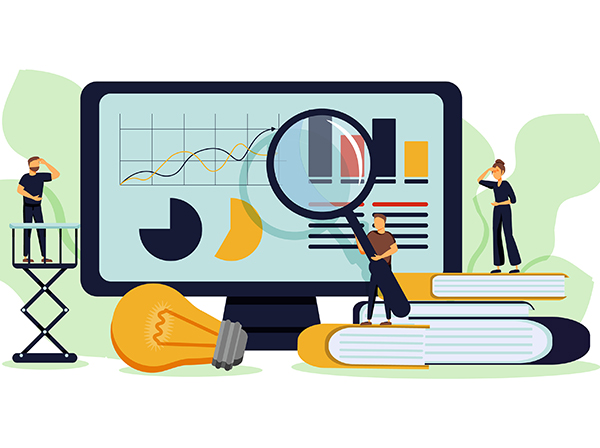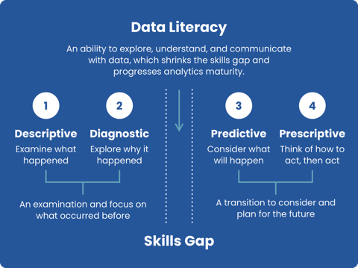
Data is the new oil. But what good is that data if we don’t know how to leverage it? According to the Human Impact of Data Literacy report, only 32% of surveyed executives felt like they were able to create measurable value from data. Organizations are struggling to make the most of the data and analytics they have – and it’s due to the lack of data literacy.
Data literacy is the ability of an individual to read, understand, and work with data to create meaningful insights from it. It’s a crucial skill in today’s data-driven world, yet only 24% of business decision-makers consider themselves data-literate. This prevents them from extracting value from the data they generate daily.
Even with all the data analytics tools available today, it’s unrealistic to expect employees to use them when they don’t understand their value or are not trained to use them. For this article, we sat down with different data experts to discuss what’s holding organizations back from becoming data-literate, as well as how data literacy and analytics can come together to create a data-driven organization.
According to Jerod Johnson, senior technology evangelist at CData:
“When line-of-business users lack data literacy, vital decisions are made based on intuition, gut feeling, and past experiences. When an organization trains its users to be data-literate, more decisions can be based on accurate data and actual results of different efforts, operations, and processes.”
The Current State of Data Usage
Gone are the days when organizations focused exclusively on big data, which required gathering as much data as possible in the shortest period. This approach led to an increase in data volume but with minimal business benefits. The issue? The data was either irrelevant to their overarching business goals or inaccessible to the users. Now, companies are in a situation where they either have the data and don’t know what to do with it – or they know what to do but don’t have the relevant data to move forward.

Even when employees have access to analyzed insights, they can’t communicate the business benefits. To do this, we need to understand where the skills gap exists. There are four levels of analytics maturity:
- Descriptive: You examine what has happened before
- Diagnostic: You identify why it happened the way it did
- Predictive: Think about what might happen once you have the data
- Prescriptive: Think about what you need to do and how to do it
There’s a massive gap between the diagnostic and predictive stages, where the need for data literacy arises. If organizations can address this skills gap, they can move on to the prescriptive stage, where the most successful data-driven organizations now sit. But if they want to achieve this, they need to invest in programs that convince internal teams about the benefits of data literacy.
According to Tim Panagos, CTO and co-founder of Microshare:
“This cycle is self-reinforcing: Data literacy and data analytics do fuel each other. More ROI leads to more belief, which leads to more action, which leads to more ROI, and so on. The trick with all such ‘virtuous cycles’ is to kick them off in the right direction and let the cycle do the rest of the work.”
Lack of Data Literacy and Its Impact
The hesitation to invest in a data literacy program is one of the biggest roadblocks for businesses. It all boils down to their data culture. For data analytics to truly provide value and impact the bottom line, leaders need to focus on creating a solid data-driven culture.
Colleen Tartow, director of engineering at Starburst Data, agrees:
“Employees at all levels must be encouraged and enabled to use data in decision-making: from the day-to-day execution to large-scale, long-term planning and strategy. Without that base level of data literacy, any data analytics program will stagnate because data is not woven into the culture of the business.”
But, creating a data-focused culture is not easy either. It requires strategic planning and implementation. As per a survey by Qlik, there are several challenges in doing so:
- Workforce resistance: Employees who are used to a specific workflow and data culture will push back against newer ones.
- Lack of a data champion: Implementing a robust data-driven culture is easier when there’s a dedicated leader in the organization – preventing resistance at all levels.
- Lack of governance: It’s crucial to have a Data Governance plan to validate the data and resulting insights at any time.
- Employee hesitation: Data from the survey shows that 21% of 16- to 24-year-olds consider themselves data-illiterate. Considering they’re the future, it’s important to implement training programs.
- Company-wide silos: Data-literate employees work separately from decision-makers and non-technical teams. Without adequate knowledge-sharing mechanisms, it’s hard to overcome hesitancy around data usage.
If they can overcome these challenges, they can avoid falling by the wayside in the next five to 10 years. There are several ways in which literacy programs can leverage analytics to implement a data-driven organizational culture.
The Intersection of Data Literacy and Analytics
Poor data literacy is the second biggest internal roadblock to a chief data officer’s success, and in turn, the business. The only way to ensure that the skills gap is closed over time is to invest in internal training programs that help organizations pave a data-driven culture.
Employees need to know how to leverage data and understand how it’s generated, processed, analyzed, and reported. This is where data literacy and analytics intersect with each other.
Here are a few ways you can increase analytics-specific data literacy within the company:
Empowering Non-Technical Users
It begins by identifying who understands data and who doesn’t. By doing so, you can identify the data champions (who lead the data initiatives) and the data mediators (who translate that information to the rest of the team). It also involves recognizing the communication barriers between the technical and non-technical users and establishing a common language. The best way to do that is to train them on the fundamentals of data and related analytics or visualization tools.
In his book “Be Data Literate,” Jordan Morrow states that:
“When organizations look to democratize data, most are not going to be able to absorb the data and information, so we need software to help simplify. In steps the powerful data and analytics tool: data visualization.”
Using user-friendly interfaces and simple data visualizations, employees can learn why specific data sets were used and how that information is translated into meaningful business insights. Continuous data engagement is essential, so companies must create such opportunities.
Boris Jabes, CEO and co-founder of Census, emphasizes this too:
“First, you can provide training on data literacy and data analytics. Additionally, you can provide tools and resources that make it easier for people to access and use data. Finally, you can create opportunities for people to engage with data. This can include contests, challenges, or simply providing interesting and relevant datasets.”
Leveraging Self-Service Analytics
Self-service analytics is a business intelligence tool that helps non-technical users perform queries and generate necessary reports on their own – without technical support. It’s a practical way to empower them and save time in the long run, as they don’t have to rely on other teams. A few popular examples include Microsoft Power BI, Tableau, and Metabase.
But there are specific challenges when you use such tools. According to Merrill Albert, data service delivery director of Trellance, just because employees have access to such tools doesn’t mean they know what data they need to access. Such tools should be implemented in tandem with literacy programs so that they can understand how to get the right analytics and insights.
Creating Citizen Data Scientists
Citizen data scientists are business users who take the initiative to create models using prescriptive or predictive analysis. But they’re not directly involved in a statistical role like typical data scientists. Every organization has that one curious employee who likes tinkering with the models themselves and unlocking the potential of their data.
Ideally, business leaders should strive to create more citizen data scientists within their departments, leading to increased data literacy and data democratization. To democratize your data, you need to empower non-technical users and give them access to the data and the tools used to analyze them.
Generating Data Catalogs
A data catalog refers to a central metadata inventory of all the available data within the company. It acts as the repository for all the internal data, which helps any employee access what they need without needing to go through an IT team.
According to Sharad Varshney, CEO of OvalEdge, a data catalog gives users open yet governed access to data assets. They can safely access the information they need knowing that personal identifiable information (PII) or other sensitive information is protected.
Foster a Data-Driven Culture Through Data Literacy
By leveraging analytics tools and implementing data literacy programs, organizations can take charge of their data and get ahead of the curve. Literacy programs must include basic training on skills such as data fundamentals, tools like Excel, Tableau, and SQL, and learning through implementation. The more business employees put these tools and skills to use, the more proficient they will become.
Image used under license from Shutterstock.com
